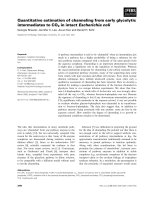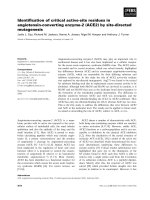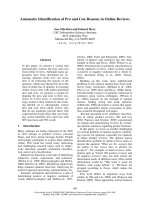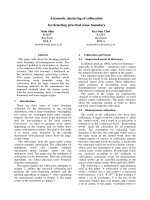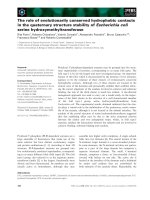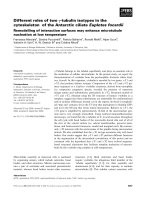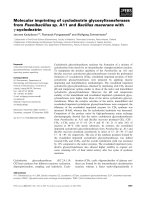Báo cáo khoa học: "Greenhouse production of nectarines for early harvest in France: a cultivation system with shallow rest or no rest" pps
Bạn đang xem bản rút gọn của tài liệu. Xem và tải ngay bản đầy đủ của tài liệu tại đây (184.03 KB, 4 trang )
Greenhouse
production
of
nectarines
for
early
harvest
in
France:
a
cultivation
system
with
shallow
rest
or
no
rest
P.
Balandier
R. Rageau
Laboratoire
de
Bioclimatologie,
INRA,
Domaine-de-Crouelle,
M0.?9
Clermont-Ferrand
Cedex,
France
Introduction
The
greenhouse
cultivation
system
was
started
in
France
5
yr
ago.
The
aim
of
this
system
was
to
supply
the
market
with
peaches
earlier
than
the
southern
Euro-
pean
countries
do
already.
Although
the
current
system
(modified
’Bellini
system’)
has
had
favorable
economic
results,
the
environmental
conditions
were
determined
empirically
and
are
probably
not
optimal.
The
feasibility
of
heating
the
greenhouse
earlier
or
increasing
the
temperature
is
often
questioned
but,
unfortunately,
there
is
a
lack
of
basic
knowledge
about
tree
physiology,
especially
in
experiments
such
as
this
one
which
involves
the
severe
cut-
ting
back
of
the
trees
in
summer.
Arias
and
Crabbe
(1975)
studying
cher-
ry
trees,
Barnola
and
co-workers
(1976)
studying
hazelnut
trees
and
Dreyer
and
Mauget
(1986)
studying
walnut
trees
found
that
buds
on
shoots
or
parts
of
shoots
which
started
growing
as
a
result
of
severe
summer
pruning
or
water
stress
never
reached
a
high
level
of
dormancy.
Erez
(1987)
carried
out
a
similar
experi-
ment
on
peach
trees
grown
under
forced
conditions
in
Israel,
but
looked
more
closely
at
bud
development:
these
particu-
lar
buds
seemed
to
experience
a
low
level
of
dormancy;
however,
this
approach
was
rather
indirect.
A
first
study
on
nectarine
trees
grown
in
a
greenhouse
was
carried
out
by
Rageau
and
Ridray
(1989),
with
the
following
conclusion:
no
dormancy
in
the
leaf
buds
and
slight
dormancy
in
the
flower
buds.
These
conclusions
still
have
to
be
confirmed,
especially
for
the
flower
buds.
Materials
and
Methods
Experiments
were
carried
out
with
3
yr
old
nec-
tarine
trees
(cv
Armking
grafted
onto
peach
rootstock
’GF
30!3’)
which
had
been
’classically’
trained
in
containers
for
greenhouse
production
(Rageau
and
Ridray,
1989).
In
June
1987,
after
the
May
harvest,
3
of
the
trees
were
taken
out-
side;
they
were
not
cut
back
(treatment
0);
in
August,
these
trees
suffered
a
brief,
but
severe
water
stress.
The
other
treatments
were:
G:
4
trees
were
kept
at
a
low
temperature
until
January
18th
and
then
afterwards
at
a
tempera-
ture
above
15°C;
G/0:
3
trees
were
taken
out-
side
on
November
20th;
H
I,10
and
H
I,15
:
on
December
22nd,
4
trees
were
put
into
tempera-
ture-conditioned
boxes
(2
at
10°C,
2
at
15°C)
and
then
they
were
put
back
into
the
green-
house
on
January
l8th;
H
II
,
10’
HII.
18
and
Hn,
2o:
on
January
l8th,
6
trees
were
put
into
tempera-
ture-conditioned
boxes
(2
at
10°C,
2
at
18°C
and
2
at
20°C)
and
then
put
back
into
the
greenhouse
on
January
28th
for
H
jj
20
and
on
February
4th
for
H
II
,
10
and
H
II
,1
8’
The
leaf
bud
growth
capacity
was
worked
out
using
the
’one
node
cuttings’
method;
it
was
quantified
by
the
arithmetic
mean
(mean
time
of
bud
burst,
MTB)
of
the
individual
burst
time
lapse
under
normal
conditions,
using
a
sample
of
about
100
buds
on
20
shoots,
for
each
sam-
pling
date.
From
15
shoots
about
100
flower
buds
were
sampled,
from
which
floral
primordia
were
removed
and
immediately
weighed.
The
mean
weight
(W)
of
the
fresh
bud
and
the
corre-
sponding
logarithm
(LW)
were
calculated
for
each
sampling
date.
A
number
was
given
to
each
segment
representing
the
growth
between
two
dates
plotted
in
Fig.
2;
the
slope
a
of
each
segment
(relative
growth
rate
during
this
period)
and
the
mean
temperature
(T)
were
calculated.
On
the
trees,
at
the
end
of
the
experiments,
using
a
large
sample
(about
500)
each
leaf
bud
was
recorded
as ’burst’
or ’not
burst’.
Results
Growth
capacity
of leaf buds
(Fig.
1)
For
all
considered
treatments,
the
regis-
tered
MTB
values
never
reached
the
’peak’
values
generally
recorded
for
peach
5 00!
trees
under
normal
cultivation
conditions
(>700
h).
With
the
0
treatment,
there
is
one
of
two
possibilities:
either
a
’peak’
value
occurred
but
was
not
recorded,
for
lack
of
suitable
sampling
date
in
October,
or
actually
it
did
not
occur
(a
possible
explanation
is
that
it
is
a
consequence
of
summer
water
stress).
With
moving
the
trees
from
the
greenhouse
to
outside
(a
few
degrees
(°C)
cooler),
the
MTB
with
the
G/0
treatment
first
decreased
at
a
more
rapid
rate,
then
afterwards
at
a
slow-
er
rate
than
with
the
G
treatment.
Growth
capacity
of
flower
buds
(Figs. 2
and 3)
Plotting
a
against
T
seemed
to
fit
a
single
response
curve,
the
same
as
the
curve
drawn
by
Rageau
(1982)
with
Redhaven
peach
trees,
during
the
post-dormancy
period.
Nevertheless,
for
many
treat-
ments,
the
a
values
corresponding
to
the
early
part
of
the
growth
curves
were
rather
low,
especially
with
the
H,
treatments
(the
very
low
value
corresponding
to
the
seg-
ment
1
of
the
H
II
,
20
treatment
seemed
to
stem
from
a
sampling
or
a
measurement
condition
problem).
Leaf
bud
breaking
on
the
trees
There
was
a
difference
between
the
bud
breaking
percents
for
the
different
treat-
ments:
G/0:
88%
(a);
G:
74%
(b);
HI,
10
:
62%
(c);
Hl,
1s
:
64%
(c);
HII,
1O
:
77%
(b);
H
II
.1B:
69%
(b,
c),
HI
I.20
:
76%
(b)
(signifi-
cantly
different
values -
5%
level -
are
referred
to
with
different
letters).
Discussion
and
Conclusion
The
buds
of
the
nectarine
trees
’classical-
ly’
trained
for
greenhouse
production
experienced
only
a
slight
true
dormancy
which
could
be
detected
for
the
leaf
buds
by
comparing
the
G
and
G/0
MTB
curves
and
for
the
flower
buds
the
dormancy
was
detected
by
the
’low’
a
values
corre-
sponding
to
the
December
and
early
January
growth
curves.
This
dormancy
seemed
easy
to
overcome,
even
with
the
H,
experimental
conditions
which
did
not
lead
to
any
problems
at
the
agronomic
level
(good
fruit
yield).
There
is
no
definite
conclusion
that
no
problems
would
exist
if
the
greenhouse
were
to
be
heated
earlier;
for
example,
differences
in
the
leaf
bud
sprouting
on
the
trees
took
place
between
the
December
and
the
January
heating
treatments
and
could
be
much
more
important
with
earlier
heating.
Further
stu-
dies
are
needed
to
obtain
more
precise
information
on
the
ability
of
the
buds
and,
more
particularly
the
floral
ones,
to
grow
during
early
autumn.
References
Arias
O.
&
Crabbe
J.
(1975)
Alterations
de
I’état
de
dormance
ult6rieur
des
bourgeons
obtenus
par
diverses
modalit6s
de
decapitation
estivale,
rdalis6es
sur
de
jeunes
plants
de
Prunus
avium
L.
C.R.
Acad.
Sci.
Ser.
D 280,
2449-2452
Barnola
P.,
Champagnat
P.
&
Lavarenne
S.
(1976)
Taille
en
vert
des
rameaux
et
dormance
des
bourgeons
chez
le
noisetier.
C.R.
Seances
Acad.
Agric.
Fr.
16, 1163-1171
Dreyer
E.
&
Mauget
J.C.
(1986)
Consequences
imm6diates
et
diff
6
r6es
de
p6riodes
de
s6che-
resse
estivale
sur
le
développement
de
jeunes
noyers
(Juglans
regia
L.
cv
-Pedro-):
dyna-
mique
de
croissance
et
de
dormance
automno-
hivernale
des
bourgeons.
Agronomie
6,
639-
650
Erez
A.
(1987)
Use
of
the
rest
avoidance
tech-
nique
in
peaches
in
Israel.
Acta
Hortic.
199,
137-144
Rageau
R.
(1982)
Etude
experimentale
des
iois
d’action
de
la
temperature
sur
la
croissance
des
bourgeons
floraux
du
pecher
(Prunus
persica
L.
Batsch)
pendant
la
post-dormance.
C.R.
Seances
Acad.
Agric.
Fr.
68,
709-718
8
Rageau
R.
&
Ridray
G.
(1989)
Nectarine
culti-
vation
in
greenhouse
for
early
harvest
in
France:
a
management
system
with
rest
avoid-
ance.
International
Peach
Symposium
I.S.H.S.,
1988,
Clemson,
SC,
U.S.A.
Acta
Hortic.
in
press


